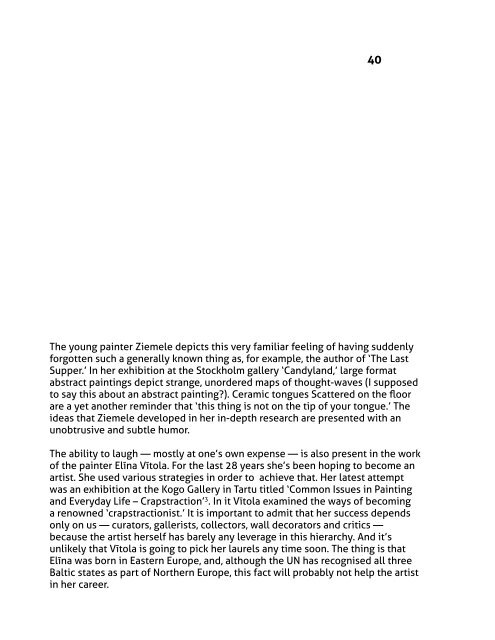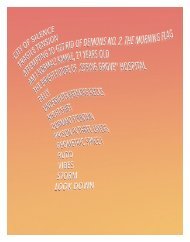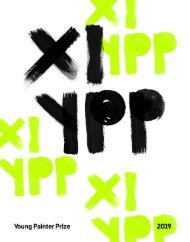X YPP Book
The main aim of the project - to discover new talent in Baltic States.
The main aim of the project - to discover new talent in Baltic States.
Create successful ePaper yourself
Turn your PDF publications into a flip-book with our unique Google optimized e-Paper software.
The young painter Ziemele depicts this very familiar feeling of having suddenly<br />
forgotten such a generally known thing as, for example, the author of ‘The Last<br />
Supper.’ In her exhibition at the Stockholm gallery ‘Candyland,’ large format<br />
abstract paintings depict strange, unordered maps of thought-waves (I supposed<br />
to say this about an abstract painting?). Ceramic tongues Scattered on the floor<br />
are a yet another reminder that ‘this thing is not on the tip of your tongue.’ The<br />
ideas that Ziemele developed in her in-depth research are presented with an<br />
unobtrusive and subtle humor.<br />
The ability to laugh — mostly at one’s own expense — is also present in the work<br />
of the painter Elīna Vītola. For the last 28 years she’s been hoping to become an<br />
artist. She used various strategies in order to achieve that. Her latest attempt<br />
was an exhibition at the Kogo Gallery in Tartu titled ‘Common Issues in Painting<br />
and Everyday Life – Crapstraction’ 3 . In it Vītola examined the ways of becoming<br />
a renowned ‘crapstractionist.’ It is important to admit that her success depends<br />
only on us — curators, gallerists, collectors, wall decorators and critics —<br />
because the artist herself has barely any leverage in this hierarchy. And it’s<br />
unlikely that Vītola is going to pick her laurels any time soon. The thing is that<br />
Elīna was born in Eastern Europe, and, although the UN has recognised all three<br />
Baltic states as part of Northern Europe, this fact will probably not help the artist<br />
in her career.<br />
40<br />
The only survivors in the complicated art market hierarchy are those who are<br />
discovered or remembered by curators. A mere glance at Vītola’s paintings might<br />
be enough to understand what we are dealing with. In order to see the image,<br />
we have to use our ‘magic eye.’ 4 in order to5 If we are lucky, a deer, a fairy, or the<br />
Lion King will appear in front of us. It might also be an upholstery pattern from a<br />
grandmother’s armchair. Or maybe you will get extremely lucky and see the artist<br />
herself, who will then tell you that, for the first time in her life, she has<br />
created a new pattern that incorporates all the previous patterns she did not<br />
invent herself. You might as well come to a conclusion that trying to find<br />
recognisable images in an abstraction is a common everyday task. Vītola has<br />
published her manifesto which I am not going to reveal to you here, as it<br />
available on her Instagram profile. It is significant that the artist reproduced her<br />
manifesto on two of her works: a painted sofa, and on an incredibly long canvas<br />
roll of which only a very tiny part is visible.<br />
In Elza Sīle’s exhibition æA Decent Little Hike on Roads Rural and Dangerous,<br />
Plus Ugly’ at the Alma Gallery one can find many things except for paintings in<br />
a classical (conservative?) sense. “I used classic painting materials: graphite, oil,<br />
and acrylic. My works — or rather my compositions — are something between a<br />
painting, a board game, and a miniature stage; they look like landscapes created<br />
with traditional painting materials and in keeping with the classical<br />
conventions,” the artist said in an interview. Despite the use of conventional<br />
materials, her approach is definitely unconventional. She utilises the painting<br />
materials as construction elements to build houses and towns, playgrounds and<br />
parks, toilets and what not. The exhibition showcased adhesive prints depicting<br />
tattoos with the reproductions of the paintings displayed in the same room, only<br />
depicted on a human body; plates with maps of imaginary places; and artist’s<br />
poetry. She places some of her works in parallel to the ground (no one said that<br />
paintings must always be placed vertically against the wall). Here are some of<br />
her poignant insights on the conventional understandings about painting (what<br />
does it even mean—creating ‘pure’ or ‘impure’ hues; or constructing a painting<br />
that is ‘too big’ or ‘too small’?):<br />
3<br />
Crapstraction – an art term related to “Zombie Formalism” coined by art critic Walter Robinson, is basically<br />
a mechanism for collectors to make loads of money. The scheme is simple: find an emerging<br />
artist-abstractionist, buy his/her work ass-cheaply, groom the artist’s name, put the work on auction and<br />
get a big buck. And now many of them, unrecognizable from each other, smoothed out and fused together,<br />
groomed and smudged, decorate the walls of the wealthy. Oh, how lovely are those decorations that do<br />
not disturb my tranquil life!<br />
4 Remember the children’s game in which, as described in spoki.tvnet.lv, one has to choose a point in a<br />
picture (it is best to start somewhere in the middle) and allow yourself to see images through keeping your<br />
focus fixed on one spot it? No need to strain your eyes and stare, simply look ‘through’ the image. It is ok<br />
to lose focus at first. Don’t give up, keep looking. After you’ve seen your first image, others will arrive with<br />
less effort.





